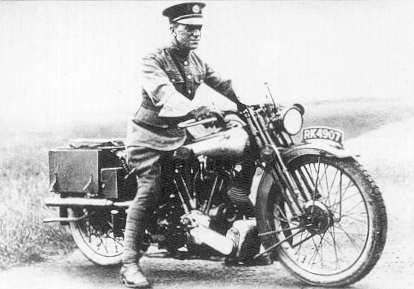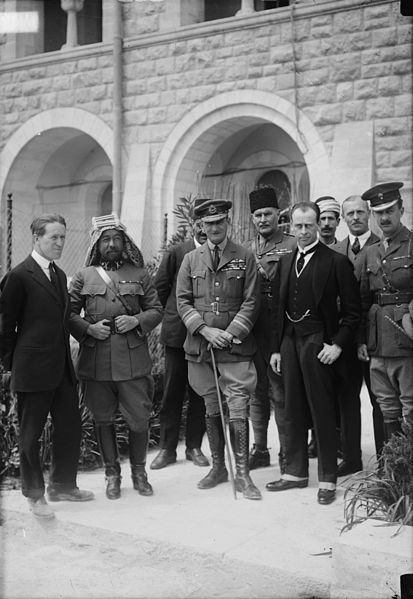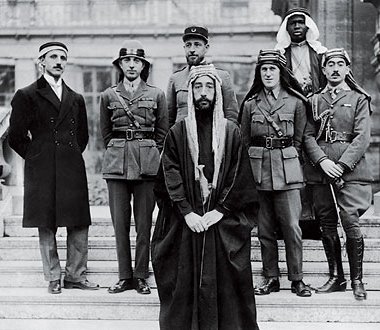<Back to Index>
- Lieutenant Colonel of the British Army Thomas Edward Lawrence, 1888
PAGE SPONSOR
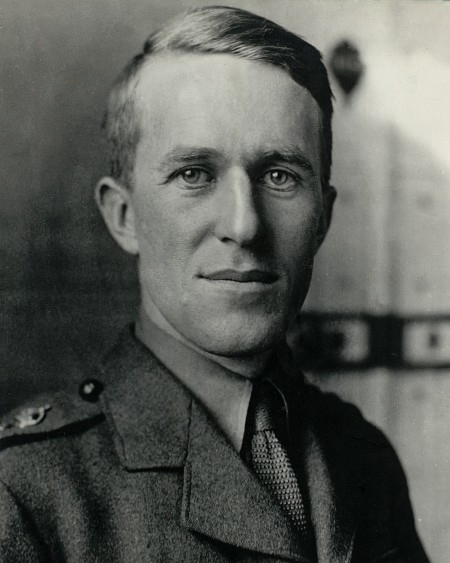
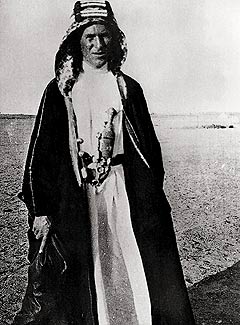
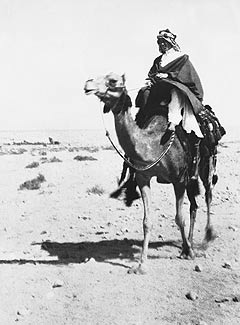
Lieutenant Colonel Thomas Edward Lawrence, CB, DSO (16 August 1888 – 19 May 1935), known professionally as T. E. Lawrence, was a British Army officer renowned especially for his liaison role during the Arab Revolt against Ottoman Turkish rule of 1916 – 18. The extraordinary breadth and variety of his activities and associations, and his ability to describe them vividly in writing, earned him international fame as Lawrence of Arabia, a title which was used for the 1962 film based on his World War I activities.
Lawrence was born illegitimately in Tremadog, Wales, in August 1888 to Sir Thomas Chapman and Sarah Junner, a governess who was herself illegitimate. Chapman had left his wife and first family in Ireland to live with Sarah Junner, and they called themselves Mr and Mrs Lawrence. In the summer of 1896 the Lawrences moved to Oxford, where in 1907 – 10 young Lawrence studied history at Jesus College, graduating with First Class Honours. He became a practicing archaeologist in the Middle East, working at various excavations with David George Hogarth and Leonard Woolley. In 1908 he joined the OUOTC (Oxford University Officer Training Corps), undergoing a two - year training course. In January 1914, before the outbreak of World War I, Lawrence was co-opted by the British military to undertake a military survey of the Negev Desert while doing archaeological research.
Lawrence's public image was due in part to American journalist Lowell Thomas' sensationalized reportage of the revolt as well as to Lawrence's autobiographical account, Seven Pillars of Wisdom (1922).
Lawrence was born on 16 August 1888 in Tremadog, Caernarfonshire (now Gwynedd), Wales, in a house named Gorphwysfa, now known as Snowdon Lodge. His Anglo - Irish father, Thomas Robert Tighe Chapman, who in 1914 inherited the title of seventh Baronet of Westmeath in Ireland, had left his wife Edith for his daughters' governess Sarah Junner. Junner's mother, Elizabeth Junner, had named as Sarah's father a "John Junner – shipwright journeyman", though she had been living as an unmarried servant in the household of a John Lawrence, ship's carpenter, just four months earlier. The couple did not marry but were known as Mr and Mrs Lawrence.
Thomas Chapman and Sarah Junner had five sons born out of wedlock, of whom Thomas Edward was the second eldest. From Wales the family moved to Kirkcudbright in Dumfries and Galloway, then Dinard in Brittany, then to Jersey. From 1894 – 96 the family lived at Langley Lodge (now demolished), set in private woods between the eastern borders of the New Forest and Southampton Water in Hampshire. Mr Lawrence sailed and took the boys to watch yacht racing in the Solent off Lepe beach. By the time they left, the eight - year - old Ned (as Lawrence became known) had developed a taste for the countryside and outdoor activities.
In the summer of 1896 the Lawrences moved to 2 Polstead Road (now marked with a blue plaque) in Oxford, where, until 1921, they lived under the names of Mr and Mrs Lawrence. Lawrence attended the City of Oxford High School for Boys, where one of the four houses was later named "Lawrence" in his honor; the school closed in 1966. As a schoolboy, one of his favorite pastimes was to cycle to country churches and make brass rubbings. Lawrence and one of his brothers became commissioned officers in the Church Lads' Brigade at St Aldate's Church.
Lawrence claimed that in about 1905, he ran away from home and served for a few weeks as a boy soldier with the Royal Garrison Artillery at St Mawes Castle in Cornwall, from which he was bought out. No evidence of this can be found in army records.
From 1907 to 1910 Lawrence studied history at Jesus College, Oxford. During the summers of 1907 and 1908, he toured France by bicycle, collecting photographs, drawings and measurements of castles dating from the medieval period. In the summer of 1909, he set out alone on a three month walking tour of crusader castles in Ottoman Syria, during which he traveled 1,000 mi (1,600 km) on foot. Lawrence graduated with First Class Honours after submitting a thesis entitled The influence of the Crusades on European Military Architecture – to the end of the 12th century based on his own field research in France, notably in Châlus, and the Middle East.
On completing his degree in 1910, Lawrence commenced postgraduate research in medieval pottery with a Senior Demy, a form of scholarship, at Magdalen College, Oxford,
which he abandoned after he was offered the opportunity to become a
practicing archaeologist in the Middle East. Lawrence was a polyglot whose published work demonstrates competence in French, Ancient Greek, and Arabic.
In December 1910 he sailed for Beirut, and on arrival went to Jbail (Byblos), where he studied Arabic. He then went to work on the excavations at Carchemish, near Jerablus in northern Syria, where he worked under D.G. Hogarth and R. Campbell - Thompson of the British Museum. He would later state that everything that he had accomplished, he owed to Hogarth. As the site lay near an important crossing on the Baghdad Railway, knowledge gathered there was of considerable importance to the military. While excavating ancient Mesopotamian sites, Lawrence met Gertrude Bell, who was to influence him during his time in the Middle East.
In late 1911, Lawrence returned to England for a brief sojourn. By November he was en route to Beirut for a second season at Carchemish, where he was to work with Leonard Woolley. Prior to resuming work there, however, he briefly worked with Flinders Petrie at Kafr Ammar in Egypt.
Lawrence continued making trips to the Middle East as a field archaeologist until the outbreak of the First World War. In January 1914, Woolley and Lawrence were co-opted by the British military as an archaeological smokescreen for a British military survey of the Negev Desert. They were funded by the Palestine Exploration Fund to search for an area referred to in the Bible as the "Wilderness of Zin"; along the way, they undertook an archaeological survey of the Negev Desert. The Negev was of strategic importance, as it would have to be crossed by any Ottoman army attacking Egypt in the event of war. Woolley and Lawrence subsequently published a report of the expedition's archaeological findings, but a more important result was an updated mapping of the area, with special attention to features of military relevance such as water sources. Lawrence also visited Aqaba and Petra.
From March to May 1914, Lawrence worked again at Carchemish.
Following the outbreak of hostilities in August 1914, Lawrence did not
immediately enlist in the British Army; on the advice of S.F. Newcombe he held back until October, when he was commissioned on the General List.
At the outbreak of the First World War Lawrence was a university post - graduate researcher who had for years traveled extensively within the Ottoman Empire provinces of the Levant (Transjordan and Palestine) and Mesopotamia (Syria and Iraq) under his own name. As such he became known to the Turkish Interior Ministry authorities and their German technical advisors. Lawrence came into contact with the Ottoman – German technical advisers, traveling over the German designed, built, and financed railways during the course of his researches.
Even if Lawrence had not volunteered, the British would probably have recruited him for his first hand knowledge of Syria, the Levant, and Mesopotamia. He was eventually posted to Cairo on the Intelligence Staff of the GOC Middle East.
Contrary to later myth, it was neither Lawrence nor the Army that conceived a campaign of internal insurgency against the Ottoman Empire in the Middle East, but rather the Arab Bureau of Britain's Foreign Office. The Arab Bureau had long felt it likely that a campaign instigated and financed by outside powers, supporting the breakaway - minded tribes and regional challengers to the Turkish government's centralized rule of their empire, would pay great dividends in the diversion of effort that would be needed to meet such a challenge. The Arab Bureau had recognized the strategic value of what is today called the "asymmetry" of such conflict. The Ottoman authorities would have to devote from a hundred to a thousand times the resources to contain the threat of such an internal rebellion compared to the Allies' cost of sponsoring it.
At that point in the Foreign Office's thinking they were not considering the region as candidate territories for incorporation in the British Empire, but only as an extension of the range of British Imperial influence, and the weakening and destruction of a German ally, the Ottoman Empire.
During the war, Lawrence fought with Arab irregular troops under the command of Emir Faisal, a son of Sherif Hussein of Mecca, in extended guerrilla operations against the armed forces of the Ottoman Empire. He persuaded the Arabs not to make a frontal assault on the Ottoman stronghold in Medina but
allowed the Turkish army to tie up troops in the city garrison. The
Arabs were then free to direct most of their attention to the Turks'
weak point, the Hejaz railway that
supplied the garrison. This vastly expanded the battlefield and tied up
even more Ottoman troops, who were then forced to protect the railway
and repair the constant damage.
In 1917, Lawrence arranged a joint action with the Arab irregulars and forces under Auda Abu Tayi (until then in the employ of the Ottomans) against the strategically located but lightly defended town of Aqaba. On 6 July, after a surprise overland attack, Aqaba fell to Lawrence and the Arab forces. After Aqaba, Lawrence was promoted to major. Fortunately for Lawrence, the new commander - in - chief of the Egyptian Expeditionary Force, General Sir Edmund Allenby, agreed to his strategy for the revolt, stating after the war:
"I gave him a free hand. His cooperation was marked by the utmost loyalty, and I never had anything but praise for his work, which, indeed, was invaluable throughout the campaign."
Lawrence now held a powerful position, as an adviser to Faisal and a person who had Allenby's confidence.
The following year, Lawrence was involved in the build up to the capture of Damascus in the final weeks of the war. Much to his disappointment, and contrary to instructions he had issued, he was not present at the city's formal surrender, arriving several hours after the city had fallen. Lawrence entered Damascus around 9am on 1 October 1918, but was only the third arrival of the day, the first being the 10th Australian Light Horse Brigade, led by Major A.C.N. 'Harry' Olden who formally accepted the surrender of the city from acting Governor Emir Said. Despite his absence for the formal surrender, he was promoted to lieutenant - colonel in late 1918 for the role he had played in the capture of Damascus. Lawrence was reportedly embittered by having been beaten into the city by the Australians, and resented them for it later in his life. In his own recollections of the capture of Damascus he completely omitted the key role played by the Australians, and this error was widely believed and later repeated by many historians.
In newly liberated Damascus — which he had envisaged as the capital of an Arab state — Lawrence was instrumental in establishing a provisional Arab government under Faisal. Faisal's rule as king, however, came to an abrupt end in 1920, after the battle of Maysaloun, when the French Forces of General Gouraud under the command of General Mariano Goybet, entered Damascus, breaking Lawrence's dream of an independent Arabia.
As was his habit when traveling before the war, Lawrence adopted many local customs and traditions (many photographs show him in the desert wearing white Arab dishdasha and riding camels).
During the closing years of the war he sought, with mixed success, to convince his superiors in the British government that Arab independence was in their interests. The secret Sykes - Picot Agreement between France and Britain contradicted the promises of independence he had made to the Arabs and frustrated his work.
In 1918 he co-operated with war correspondent Lowell Thomas for
a short period. During this time Thomas and his cameraman Harry Chase
shot a great deal of film and many photographs, which Thomas used in a
highly lucrative film that toured the world after the war.
Immediately after the war, Lawrence worked for the Foreign Office, attending the Paris Peace Conference between January and May as a member of Faisal's delegation. He served for much of 1921 as an advisor to Winston Churchill at the Colonial Office.
In August 1919, the American journalist Lowell Thomas launched a colorful photo show in London entitled With Allenby in Palestine which included a lecture, dancing, and music. Initially, Lawrence played only a supporting role in the show, but when Thomas realized that it was the photos of Lawrence dressed as a Bedouin that had captured the public's imagination, he shot some more photos in London of him in Arab dress. With the new photos, Thomas re-launched his show as With Allenby in Palestine and Lawrence in Arabia in early 1920; it was extremely popular. Thomas' shows made Lawrence, who until then been rather obscure, into a household name.
In August 1922, Lawrence enlisted in the Royal Air Force as an aircraftman under the name John Hume Ross, at RAF Uxbridge. He was soon exposed and, in February 1923, was forced out of the RAF. He changed his name to T.E. Shaw and joined the Royal Tank Corps in 1923. He was unhappy there and repeatedly petitioned to rejoin the RAF, which finally readmitted him in August 1925. A fresh burst of publicity after the publication of Revolt in the Desert resulted in his assignment to a remote base in British India in
late 1926, where he remained until the end of 1928. At that time he was
forced to return to Britain after rumors began to circulate that he
was involved in espionage activities.
He purchased several small plots of land in Chingford, built a hut and swimming pool there, and visited frequently. This was removed in 1930 when the Chingford Urban District Council acquired the land and passed it to the City of London Corporation, but re-erected the hut in the grounds of The Warren, Loughton, where it remains, neglected, today. Lawrence's tenure of the Chingford land has now been commemorated by a plaque fixed on the sighting obelisk on Pole Hill.
He continued serving in the RAF based at Bridlington, East Riding of Yorkshire, specializing in high - speed boats and professing happiness, and it was with considerable regret that he left the service at the end of his enlistment in March 1935.
Lawrence was a keen motorcyclist, and, at different times, had owned seven Brough Superior motorcycles. His seventh motorcycle is on display at the Imperial War Museum. Among the books Lawrence is known to have carried with him on his military campaigns is Thomas Malory's Morte D'Arthur. Accounts of the 1934 discovery of the Winchester Manuscript of the Morte include a report that Lawrence followed Eugene Vinaver — a Malory scholar — by motorcycle from Manchester to Winchester upon reading of the discovery in The Times.
At the age of 46, two months after leaving the service, Lawrence was fatally injured in an accident on his Brough Superior SS100 motorcycle in Dorset, close to his cottage, Clouds Hill, near Wareham. A dip in the road obstructed his view of two boys on their bicycles; he swerved to avoid them, lost control and was thrown over the handlebars. He died six days later on 19 May 1935. The spot is marked by a small memorial at the side of the road.
The circumstances of Lawrence's death had far reaching consequences. One of the doctors attending him was the neurosurgeon Hugh Cairns. He was profoundly affected by the incident, and consequently began a long study of what he saw as the unnecessary loss of life by motorcycle dispatch riders through head injuries. His research led to the use of crash helmets by both military and civilian motorcyclists.
Moreton Estate, which borders Bovington Camp, was owned by family cousins, the Frampton family. Lawrence had rented and later bought Clouds Hill from the Framptons. He had been a frequent visitor to their home, Okers Wood House, and had for years corresponded with Louisa Frampton. On Lawrence's death, his mother arranged with the Framptons for him to be buried in their family plot at Moreton Church. His coffin was transported on the Frampton estate's bier. Mourners included Winston and Clementine Churchill and Lawrence's youngest brother, Arnold.
A bust of Lawrence was placed in the crypt at St Paul's Cathedral and a stone effigy by Eric Kennington remains in the Anglo - Saxon church of St Martin, Wareham.
Throughout his life, Lawrence was a prolific writer. A large portion of his output was epistolary; he often sent several letters a day. Several collections of his letters have been published. He corresponded with many notable figures, including George Bernard Shaw, Edward Elgar, Winston Churchill, Robert Graves, Noël Coward, E.M. Forster, Siegfried Sassoon, John Buchan, Augustus John and Henry Williamson. He met Joseph Conrad and commented perceptively on his works. The many letters that he sent to Shaw's wife, Charlotte, offer a revealing side of his character.
In his lifetime, Lawrence published four major texts. Two were translations: Homer's Odyssey, and The Forest Giant — the latter an otherwise forgotten work of French fiction. He received a flat fee for the second translation, and negotiated a generous fee plus royalties for the first.
Lawrence's major work is Seven Pillars of Wisdom, an account of his war experiences. In 1919 he had been elected to a seven - year research fellowship at All Souls College, Oxford, providing him with support while he worked on the book. In addition to being a memoir of his experiences during the war, certain parts also serve as essays on military strategy, Arabian culture and geography, and other topics. Lawrence re-wrote Seven Pillars of Wisdom three times; once "blind" after he lost the manuscript while changing trains at Reading railway station.
The list of his alleged "embellishments" in Seven Pillars is long, though many such allegations have been disproved with time, most definitively in Jeremy Wilson's authorized biography. However Lawrence's own notebooks refute his claim to have crossed the Sinai Peninsula from Aqaba to the Suez Canal in just 49 hours without any sleep. In reality this famous camel ride lasted for more than 70 hours and was interrupted by two long breaks for sleeping which Lawrence omitted when he wrote his book.
Lawrence acknowledged having been helped in the editing of the book by George Bernard Shaw. In the preface to Seven Pillars, Lawrence offered his "thanks to Mr. and Mrs. Bernard Shaw for countless suggestions of great value and diversity: and for all the present semicolons."
The first public edition was published in 1926 as a high priced private subscription edition, printed in London by Roy Manning Pike and Herbert John Hodgson, with illustrations by Eric Kennington, Augustus John, Paul Nash, Blair Hughes - Stanton and his wife Gertrude Hermes.
Lawrence was afraid that the public would think that he would make a
substantial income from the book, and he stated that it was written as a
result of his war service. He vowed not to take any money from it, and
indeed he did not, as the sale price was one third of the production
costs. This left Lawrence in substantial debt.
Revolt in the Desert was an abridged version of Seven Pillars, which he began in 1926 and was published in March 1927 in both limited and trade editions. He undertook a needed but reluctant publicity exercise, which resulted in a best seller. Again he vowed not to take any fees from the publication, partly to appease the subscribers to Seven Pillars who had paid dearly for their editions. By the fourth reprint in 1927, the debt from Seven Pillars was paid off. As Lawrence left for military service in India at the end of 1926, he set up the "Seven Pillars Trust" with his friend D.G. Hogarth as a trustee, in which he made over the copyright and any surplus income of Revolt in the Desert. He later told Hogarth that he had "made the Trust final, to save myself the temptation of reviewing it, if Revolt turned out a best seller."
The
resultant trust paid off the debt, and Lawrence then invoked a clause
in his publishing contract to halt publication of the abridgment in the
UK. However, he allowed both American editions and translations, which
resulted in a substantial flow of income. The trust paid income either
into an educational fund for children of RAF officers who lost their lives or were invalided as a result of service, or more substantially into the RAF Benevolent Fund.
Lawrence left unpublished The Mint, a memoir of his experiences as an enlisted man in the Royal Air Force. For this, he worked from a notebook that he kept while enlisted, writing of the daily lives of enlisted men and his desire to be a part of something larger than himself: the Royal Air Force. The book is stylistically very different from Seven Pillars of Wisdom, using sparse prose as opposed to the complicated syntax found in Seven Pillars. It was published posthumously, edited by his brother, Professor A.W. Lawrence.
After Lawrence's death, A.W. Lawrence inherited all Lawrence's estate and his copyrights as the sole beneficiary. To pay the inheritance tax, he sold the U.S. copyright of Seven Pillars of Wisdom (subscribers' text) outright to Doubleday Doran in 1935. Doubleday still controls publication rights of this version of the text of Seven Pillars of Wisdom in the USA. In 1936 Prof. Lawrence split the remaining assets of the estate, giving Clouds Hill and many copies of less substantial or historical letters to the nation via the National Trust, and then set up two trusts to control interests in T.E. Lawrence's residual copyrights. To the original Seven Pillars Trust, Prof. Lawrence assigned the copyright in Seven Pillars of Wisdom, as a result of which it was given its first general publication. To the Letters and Symposium Trust, he assigned the copyright in The Mint and all Lawrence's letters, which were subsequently edited and published in the book T. E. Lawrence by his Friends.
A
substantial amount of income went directly to the RAF Benevolent Fund
or for archaeological, environmental, or academic projects. The two
trusts were amalgamated in 1986 and, on the death of Prof. A.W.
Lawrence, the unified trust also acquired all the remaining rights to
Lawrence's works that it had not owned, plus rights to all of Prof.
Lawrence's works.
A map of the Middle East that belonged to Lawrence has been put on exhibition at the Imperial War Museum in London. It was drafted by him and presented to Britain's War Cabinet in November 1918.
The
map provides an alternative to present day borders in the region,
apparently partly designed with the intention to marginalize the
post - war role of France in the region by limiting its direct colonial
control to today's Lebanon. It includes a separate state for the Armenians, a separate state of Palestine, and groups the people of present day Syria, Jordan and parts of Saudi Arabia in another state, based on tribal patterns and commercial routes.
Lawrence's biographers have discussed his sexuality at considerable length, and this discussion has spilled into the popular press.
There is no reliable evidence for consensual sexual intimacy between Lawrence and any person. His friends have expressed the opinion that he was asexual, and Lawrence himself specifically denied, in multiple private letters, any personal experience of sex. While there were suggestions that Lawrence had been intimate with Dahoum, who worked with Lawrence at a pre - war archaeological dig in Carchemish, and fellow serviceman R.A.M. Guy, his biographers and contemporaries have found them unconvincing.
The dedication to his book Seven Pillars is a poem entitled "To S.A." which opens:
- I loved you, so I drew these tides of men into my hands
and wrote my will across the sky in stars
To earn you Freedom, the seven - pillared worthy house,
that your eyes might be shining for me
When we came.
Lawrence was never specific about the identity of "S.A." There are many theories which argue in favor of individual men, women, and the Arab nation. The most popular is that S.A. represents (at least in part) his companion Selim Ahmed, "Dahoum", who apparently died of typhus prior to 1918.
Although Lawrence lived in a period during which official opposition to homosexuality was strong, his writing on the subject was tolerant. In Seven Pillars, when discussing relationships between young male fighters in the war, he refers on one occasion to "the openness and honesty of perfect love" and on another to "friends quivering together in the yielding sand with intimate hot limbs in supreme embrace". In a letter to Charlotte Shaw he wrote "I've seen lots of man - and - man loves: very lovely and fortunate some of them were."
In both Seven Pillars and a 1919 letter to a military colleague, Lawrence describes an episode in November 1917 in which, while reconnoitring Dera'a in disguise, he was captured by the Turkish military, heavily beaten, and sexually abused by the local Bey and his guardsmen. The precise nature of the sexual contact is not specified. Although there is no independent evidence, the multiple consistent reports, and the absence of evidence for outright invention in Lawrence's works, make the account believable to his biographers. At least three of Lawrence's biographers (Malcolm Brown, John Mack, and Jeremy Wilson) have argued this episode had strong psychological effects on Lawrence which may explain some of his unconventional behavior in later life.
There is considerable evidence that Lawrence was a masochist. In his description of the Dera'a beating, Lawrence wrote "a delicious warmth, probably sexual, was swelling through me", and also included a detailed description of the guards' whip in a style typical of masochists' writing. In later life, Lawrence arranged to pay a military colleague to administer beatings to him, and to be subjected to severe formal tests of fitness and stamina. While John Bruce, who first wrote on this topic, included some other claims which were not credible, Lawrence's biographers regard the beatings as established fact.
John E. Mack sees a possible connection between T.E.'s masochism and the childhood beatings he had received from his mother for routine misbehaviors. His brother Arnold thought the beatings had been given for the purpose of breaking T.E.'s will.
Lawrence's biographer Flora Armitage writes about his illegitimacy: "The effect on... Lawrence of this discovery was profound; it added to the romantic urge for heroic conduct — the dream of the Sangreal — the seed of ambition, the desire for honor and distinction: the redemption of the blood from its taint."
Another biographer, John E. Mack, writes in a similar vein:
[H]is mother required of him that he redeem her fallen state by his own special achievements, by being a person of unusual value who accomplishes great deeds, preferably religious and ideally on an heroic scale. Lawrence did his best to fulfill heroic deeds. But he was plagued, especially after the events of the war activated his inner conflicts, by a deep sense of failure. Having been deceived as a child he was later to feel that he himself was a deceiver — that he had deceived the Arabs...
Mrs. Lawrence's original hope that her sons would provide her personal redemption by becoming Christian missionaries was fulfilled only by [Lawrence's brother] Robert.
Mack elaborates further:
Part of [T.E. Lawrence's] creativity and originality lies in his "irregularity," in his capacity to remain outside conventional ways of thinking, a tendency which... derives, at least in part, from his illegitimacy.... He was not limited to established or "legitimate" solutions or ways of doing things, and thus his mind was open to a wider range of possibilities and opportunities. [At the same time] Lawrence's illegitimacy had important social consequences and placed limitations upon him, which rankled him deeply... At times he felt socially isolated when erstwhile friends shunned him upon learning of his background. Lawrence's delight in making fun of regular officers and other segments of "regular" society... derived... at least in part from his inner view of his own irregular situation. His fickleness about names for himself is directly related... to his view of his parents and to his identification with them.
